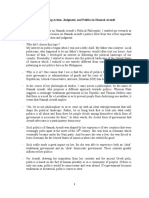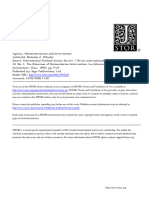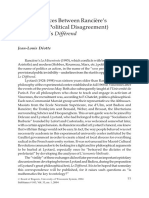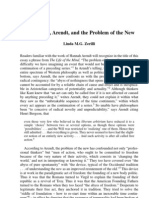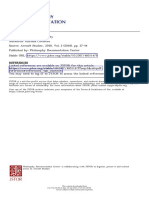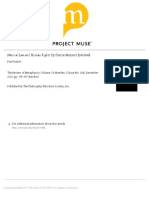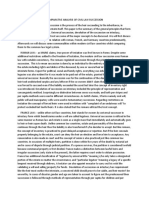Two Quotes and Thoughts
Two Quotes and Thoughts
Uploaded by
lht136601537Copyright:
Available Formats
Two Quotes and Thoughts
Two Quotes and Thoughts
Uploaded by
lht136601537Original Title
Copyright
Available Formats
Share this document
Did you find this document useful?
Is this content inappropriate?
Copyright:
Available Formats
Two Quotes and Thoughts
Two Quotes and Thoughts
Uploaded by
lht136601537Copyright:
Available Formats
Two quotes and thoughts
1. TOWARD EMBODIED VIRTUALITY
Quote:
The chapters that follow will show what had to be elided, suppressed, and forgotten to make
information lose its body. This book is a “rememory” in the sense of Toni Morrison’s Beloved:
putting back together parts that have lost touch with one another and reaching out toward a
complexity too unruly to fit into disembodied ones and zeros. (p.13)
The general idea of this point:
Historical Development of Virtuality: The author traces the historical development of the
perception of the world as an interplay between informational patterns and material objects. This
construction emerged notably after World War II, influenced by cybernetics.
The perception of virtuality, viewing material objects as interpenetrated by information patterns,
emerged in the wake of World War II. By 1948, thinkers like Wiener had articulated the distinction
between information and matter, emphasizing that "information is information, not matter or
energy." This definition is not merely a psychological phenomenon but is instantiated in
various powerful technologies.
2. Rancière: Who Is the Subject of the Rights of Man?
Quote:
"Consensus means closing the spaces of dissensus by plugging the intervals and patching over
the possible gaps between appearance and reality or law and fact."(p.306)
The article explores the complex relationship between the Rights of Man and the concept of the
subject. Rancière engages with the ideas of other philosophers, such as Giorgio Agamben and
Hannah Arendt, to discuss how political subjects emerge in the context of rights and citizenship.
The text delves into the implications of political dissensus, the nature of bare life, and the role of
humanitarianism in shaping the discourse around human rights.
Research Question: The article seeks to answer the question of who constitutes the subject of the
Rights of Man and how the concept of political subjectivity interacts with the notion of rights.
About Rancière’s critique on Arendt:
Jacques Rancière offers a critical perspective on Hannah Arendt's conception of political subjects
and the nature of democracy. Here are some key aspects of Rancière's critique towards Arendt:
Concept of Political Subject:
Rancière challenges Arendt's distinction between "man" and the "citizen." While Arendt suggests a
fundamental division between those who belong to the political realm (citizens) and those who do
not (humans), Rancière argues that this distinction is not a sign of disjunction but rather an
opening for political subjectivization.
Rancière introduces the concept of "dissensus," emphasizing that true politics involves a capacity
to stage scenes of dissensus. He criticizes Arendt's idea of consensus, which, according to
Rancière, attempts to get rid of politics by replacing surplus subjects with predefined social
groups, identity groups, and other partners.
In summary, Rancière's critique of Arendt revolves around his emphasis on dissensus, the role of
surplus subjects, and the dynamic relationship between the Rights of Man and their dissensual
stage. He argues against the depoliticizing tendencies inherent in Arendt's ideas and suggests a
more inclusive understanding of political subjects.
My personal thoughts:
Virtuality: A Way of Eliminating Dissensus?
You might also like
- Arendt On The Public and Private RealmDocument3 pagesArendt On The Public and Private RealmKevin ZhaoNo ratings yet
- Study of Atm and Deposit MachineDocument58 pagesStudy of Atm and Deposit MachineManpreetSinghRajput60% (5)
- Aredt La Sombra de ToquevilleDocument29 pagesAredt La Sombra de ToquevilleRaul Oscar AmadoNo ratings yet
- Understanding Action, Judgment, and Politics in Hannah Arendt 1. Introduction/AbstractDocument16 pagesUnderstanding Action, Judgment, and Politics in Hannah Arendt 1. Introduction/AbstractEmerson Cajayon MaalaNo ratings yet
- Arendt TocquevilleDocument29 pagesArendt TocquevilleFranco CastorinaNo ratings yet
- Heuer PluralityDocument10 pagesHeuer PluralityweltfremdheitNo ratings yet
- Wolin - Arendt DemocracyDocument18 pagesWolin - Arendt DemocracyAndrea PNo ratings yet
- Hannah Arendt - Critical Modernism Between Past and FutreDocument26 pagesHannah Arendt - Critical Modernism Between Past and Futreaam105No ratings yet
- Manent On StraussDocument18 pagesManent On StraussmythridatesNo ratings yet
- (97a) Agency, Humanitarianism and InterventionDocument18 pages(97a) Agency, Humanitarianism and Interventionbeserious928No ratings yet
- Claude Lefort-Thinking With and Against ArendtDocument14 pagesClaude Lefort-Thinking With and Against ArendtPraveen ParasarNo ratings yet
- Benhabib - Moving Beyond False Binarisms On Samuel Moyn's The Last Utopia (2013)Document14 pagesBenhabib - Moving Beyond False Binarisms On Samuel Moyn's The Last Utopia (2013)Anita Hassan Ali SilveiraNo ratings yet
- Lyotard Vs RancierDocument14 pagesLyotard Vs RancierSergio RuvalcabaNo ratings yet
- Arendt HannahDocument6 pagesArendt HannahKellyNo ratings yet
- What To Think About at The Public Space 2021Document17 pagesWhat To Think About at The Public Space 2021valeriszydlowskaNo ratings yet
- Politics Violence and StateDocument36 pagesPolitics Violence and StateRaNo ratings yet
- Anarchism and Political PhilosophyDocument17 pagesAnarchism and Political PhilosophyDavidAWWNo ratings yet
- Arendt and BrochDocument16 pagesArendt and BrochweltfremdheitNo ratings yet
- 1.3 - Isaac, Jeffrey C. - Arendt, Camus and Postmodern Politics (En)Document25 pages1.3 - Isaac, Jeffrey C. - Arendt, Camus and Postmodern Politics (En)Johann Vessant RoigNo ratings yet
- SRQR From Politics - Chatterjee Ch.1Document13 pagesSRQR From Politics - Chatterjee Ch.1NatasathNo ratings yet
- Book Reviews - Wm. Theodore DE BARY and TU Weiming (Eds.), Confucianism and Human Rights.Document6 pagesBook Reviews - Wm. Theodore DE BARY and TU Weiming (Eds.), Confucianism and Human Rights.MiguelNo ratings yet
- Vandeputte Devischoct11 PDFDocument10 pagesVandeputte Devischoct11 PDFdicoursfigureNo ratings yet
- 248) Compiled Crux Hanna ArendtDocument10 pages248) Compiled Crux Hanna Arendtdorabil534No ratings yet
- 33 Pol Theory 158Document32 pages33 Pol Theory 158Surf Boy2001No ratings yet
- Hannah Arendt, Agency, and The Public Space - IWMDocument11 pagesHannah Arendt, Agency, and The Public Space - IWMBodyConcept Marquês PortoNo ratings yet
- 214 503 1 PBDocument12 pages214 503 1 PBЕмануела НачевскаNo ratings yet
- ArendtDocument2 pagesArendtmiloiloloo75No ratings yet
- Raine Smith - Ece Assignment 2Document9 pagesRaine Smith - Ece Assignment 2api-664248097No ratings yet
- Marshall, D. L. - 2010 - The Origin and Character of Hannah Arendt's Theory of JudgmentDocument27 pagesMarshall, D. L. - 2010 - The Origin and Character of Hannah Arendt's Theory of JudgmentcontulmmivNo ratings yet
- DELOS REYES, Steve - Reflexivism - Activity1Document7 pagesDELOS REYES, Steve - Reflexivism - Activity1Fanboy KimNo ratings yet
- Balibar - EqualibertyDocument375 pagesBalibar - EqualibertySicofantisNo ratings yet
- Hannah Arendt's Kantian Socrates: Moral and Political JudgingDocument21 pagesHannah Arendt's Kantian Socrates: Moral and Political JudgingDiego FerraciniNo ratings yet
- 4 Public and Common(s) : Reinhold MartinDocument8 pages4 Public and Common(s) : Reinhold Martinkinodox941No ratings yet
- Editorial 20th Issue July 2019Document4 pagesEditorial 20th Issue July 2019michael r d jamesNo ratings yet
- Final Version Master Thesis MJ DJDocument53 pagesFinal Version Master Thesis MJ DJJoão Batista Farias JuniorNo ratings yet
- From Nomos To Lex: Hannah Arendt On Law, Politics, and OrderDocument21 pagesFrom Nomos To Lex: Hannah Arendt On Law, Politics, and OrderMohamed SoffarNo ratings yet
- 05.0 PP 33 67 Rethinking Reflective Judgment As EmbodiedDocument35 pages05.0 PP 33 67 Rethinking Reflective Judgment As EmbodiedBrian CaterinoNo ratings yet
- Bernasconi, Robert - The Double Face of The Political and The Social - Arendt and Americas Racial Divisions (Artigo)Document23 pagesBernasconi, Robert - The Double Face of The Political and The Social - Arendt and Americas Racial Divisions (Artigo)Giovana OliveiraNo ratings yet
- Castoriadis Arendt and The Problem of The NewDocument14 pagesCastoriadis Arendt and The Problem of The Newradical_imaginaryNo ratings yet
- (15691640 - Research in Phenomenology) Towards An Arendtian Conception of JusticeDocument24 pages(15691640 - Research in Phenomenology) Towards An Arendtian Conception of JusticeweltfremdheitNo ratings yet
- American Political Science Association The American Political Science ReviewDocument3 pagesAmerican Political Science Association The American Political Science ReviewShannon TaylorNo ratings yet
- Egoistic AssociationDocument11 pagesEgoistic AssociationstirnerzNo ratings yet
- AnnotatedDocument13 pagesAnnotated0nooodleNo ratings yet
- This Content Downloaded From 132.174.248.50 On Sun, 30 Apr 2023 17:19:22 +00:00Document9 pagesThis Content Downloaded From 132.174.248.50 On Sun, 30 Apr 2023 17:19:22 +00:00Matteo CinottiNo ratings yet
- Natural Law and Human Rights: Toward a Recovery of Practical ReasonFrom EverandNatural Law and Human Rights: Toward a Recovery of Practical ReasonRating: 3 out of 5 stars3/5 (3)
- Criticism 54 1 HainesDocument31 pagesCriticism 54 1 HainespavlatcheNo ratings yet
- (A John Hope Franklin Center Book) Étienne Balibar, James Ingram-Equaliberty - Political Essays-Duke University Press Books (2014) PDFDocument375 pages(A John Hope Franklin Center Book) Étienne Balibar, James Ingram-Equaliberty - Political Essays-Duke University Press Books (2014) PDFCamilo Gallo GómezNo ratings yet
- Critical Legal Thinking: Hannah Arendt: The Right To Have RightsDocument5 pagesCritical Legal Thinking: Hannah Arendt: The Right To Have RightsRogelio MendozaNo ratings yet
- Equaliberty: Political Essays by Étienne BalibarDocument53 pagesEqualiberty: Political Essays by Étienne BalibarDuke University Press50% (4)
- Constructivism (International Relations)Document8 pagesConstructivism (International Relations)ReubenPhilipNo ratings yet
- Chapter One Post-Humanism: Life Beyond The SelfDocument12 pagesChapter One Post-Humanism: Life Beyond The SelfDaveShawNo ratings yet
- Beckett MaterialDocument9 pagesBeckett MaterialYousaf KhanNo ratings yet
- Quotes ContextDocument14 pagesQuotes ContextChura Alarcon Rocio SalomeNo ratings yet
- Nietzsche and Weber On Personality and DDocument15 pagesNietzsche and Weber On Personality and DF. ANo ratings yet
- Straume A Common World EJSTDocument17 pagesStraume A Common World EJSTannipNo ratings yet
- Rorty Post Metaphysical CultureDocument9 pagesRorty Post Metaphysical CultureJesúsNo ratings yet
- Benhabib - Hannah Arendt and The Redemptive Power of NarrativeDocument31 pagesBenhabib - Hannah Arendt and The Redemptive Power of NarrativeSara Gálvez MancillaNo ratings yet
- A Formal Epistemology of International RelationsDocument46 pagesA Formal Epistemology of International RelationsAdri BerttaliNo ratings yet
- Neorealisms Advancement On Traditional R PDFDocument9 pagesNeorealisms Advancement On Traditional R PDFBetterNo ratings yet
- Natural Law and Human Rights by Pierre Manent (Review) Paul SeatonDocument4 pagesNatural Law and Human Rights by Pierre Manent (Review) Paul SeatonIrene HernandezNo ratings yet
- Thinking Without a Banister: Essays in Understanding, 1953-1975From EverandThinking Without a Banister: Essays in Understanding, 1953-1975Rating: 4.5 out of 5 stars4.5/5 (6)
- Grade 8 Civics Chapter 6Document4 pagesGrade 8 Civics Chapter 6Latha VarugheseNo ratings yet
- Real Estate Social Media Marketing BlueprintDocument11 pagesReal Estate Social Media Marketing BlueprintBirhane GebreegziabiherNo ratings yet
- Banker ResumeDocument20 pagesBanker ResumeTony JacobNo ratings yet
- UNIT 6 - Bridging The Gap 1Document19 pagesUNIT 6 - Bridging The Gap 1ChiNo ratings yet
- Cdi 211 Midterm 2ND SessionDocument7 pagesCdi 211 Midterm 2ND SessionJohn Lester SuarezNo ratings yet
- TP3 LP and Slides AnDocument15 pagesTP3 LP and Slides AnKhuê PhạmNo ratings yet
- Performance Evaluation of Hybrid Fiber Reinforced Concrete Using Copper Slag As Replacement Material of Fine AggregateDocument4 pagesPerformance Evaluation of Hybrid Fiber Reinforced Concrete Using Copper Slag As Replacement Material of Fine AggregateEditor IJTSRDNo ratings yet
- Course Outline (Global Trends)Document4 pagesCourse Outline (Global Trends)alikalkidan0088No ratings yet
- تاسيس جرامر اعداديDocument90 pagesتاسيس جرامر اعداديAmera MohamedNo ratings yet
- David C. Mcclelland: Volume Iv: Clinical, Applied and Cross - Cultural ResearchDocument9 pagesDavid C. Mcclelland: Volume Iv: Clinical, Applied and Cross - Cultural ResearchNahid HassanNo ratings yet
- 1334895952250satyam by G RameshDocument48 pages1334895952250satyam by G RameshHay Day RNo ratings yet
- Assignment 2: Importance of ConstitutionDocument3 pagesAssignment 2: Importance of ConstitutionSahibzada Arham Anwaar BugviNo ratings yet
- A Comparative Analysis of Civil Law SuccessionDocument3 pagesA Comparative Analysis of Civil Law Successionliya100% (1)
- NLC ReflectionDocument3 pagesNLC ReflectionRYAN CARLO LAPUAG86% (7)
- Curriculum 2018 FinalDocument4 pagesCurriculum 2018 FinalSilvio Abimael Miranda LopezNo ratings yet
- Science, Technology and Society Syllabus (BS Criminology) (BELARO)Document12 pagesScience, Technology and Society Syllabus (BS Criminology) (BELARO)Ernesto Luzaran Jr.100% (1)
- Student Name Fathername Gender Rollno Admission DateDocument6 pagesStudent Name Fathername Gender Rollno Admission DatekomalNo ratings yet
- Nicholas Kube: ObjectiveDocument3 pagesNicholas Kube: Objectiveapi-302202746No ratings yet
- Ultimate Guide For Descriptive English: Free E-BookDocument11 pagesUltimate Guide For Descriptive English: Free E-BookRaja ShekarNo ratings yet
- Md. Ashikul IslamDocument2 pagesMd. Ashikul IslamShah Mohammad IbrahimNo ratings yet
- Original Payal's Sip ProjectDocument50 pagesOriginal Payal's Sip ProjectSnehasish Sarkar100% (1)
- WCF Best PracticesDocument10 pagesWCF Best PracticesJacob MelladoNo ratings yet
- Topolski Poland 1986 - TextDocument215 pagesTopolski Poland 1986 - Textseddit100% (1)
- Corporate Governance of Information Technology - WikipediaDocument24 pagesCorporate Governance of Information Technology - Wikipediasofwan romli MuhammadNo ratings yet
- 1918 Flu - How It HappenedDocument7 pages1918 Flu - How It Happenedhhelp12255No ratings yet
- 3EChem PRACTICE PAPER 2Document17 pages3EChem PRACTICE PAPER 2Alley EioNo ratings yet
- Acute Mesenteric IschemiaDocument20 pagesAcute Mesenteric IschemiasolysanNo ratings yet
- Chapter 1Document4 pagesChapter 1Mamun RanaNo ratings yet



